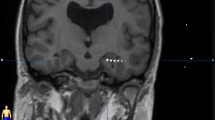Abstract
-
1.
A model of a neuronal network has been set up in a digital computer based on histological and biophysical data experimentally obtained from the thalamus; the model includes two populations of neurons interconnected by means of negative feedback; in the model allowance is also made for other sort of interactions.
-
2.
To test the hypothesis that the alpha-rhythm (8–13 Hz rhythmic activity characteristic of the EEG) is a filtered noise signal the simulated neuronal network was stimulated by random trains of pulses with a Poisson distribution. The density of pulses fired by the simulated neurons was computed as well as the oscillations of the mean membrane potential of the population of simulated neurons. The latter was found to be equivalent to the experimentally obtained alpha rhythms.
-
3.
In order to test the hypothesis that several noise sources are responsible for thalamo-cortical coherences three simulated neuronal networks were coupled together using several noise sources as secondary inputs. It was shown that although all the networks produced simulated alpha signals with identical spectra they could have significantly different values of coherence depending on the relation between correlated and uncorrelated input signals.
-
4.
The model was analysed by means of linear systems analysis after introducing the necessary simplifications and approximations. In this way it was possible to evaluate the influence of different physiological or histological parameters upon the statistical properties of the resulting rhythmic activity in an analytical form.
-
5.
By changing the model parameters it was shown that a family of spectral curves could be obtained which simulated the development of the EEG as function of age from a predominantly low frequency to a clearly rhythmic type of signal. This was shown to depend mainly on the feedback coupling parameters.
Similar content being viewed by others
References
Andersen,P., Gillow,M., Rudjord,T.: Rhythmic activity in a simulated neuronal network. J. Physiol. (Lond.) 418–428 (1966)
Fuster,J.M., Herz,A., Creutzfeldt,O.D.: Interval analysis of cell discharges in spontaneous and optically modulated activity in the visual system. Arch. ital. Biol. 103, 159–177 (1965)
Lopes da Silva,F.H., Van Lierop,T.H.M.T., Schrijer,C.F., Storm van Leeuwen,W.: Organization of thalamic and cortical alpha rhythms: spectra and coherences. Electroenceph. clin. Neurophysiol. 35, 627–639 (1973)
Levick,W.R., Williams,W.O.: Maintained activity of lateral geniculate neurons in darkness. J. Physiol. (Lond.) 170, 582–597 (1964)
Purpura,D.: Operations and processes in thalamic and synaptically related neural subsystems. In: Schmitt,F.O. (Ed.): The Neurosciences. Vol. 2, pp. 458–470. New York: Rockefeller Univ. Press 1970
Rashevsky,N.: A note on nonperiodic undamped oscillations with special reference to brain waves. Bull. Math. Biophys. 33, 281–293 (1971)
Saunders,M.G.: Amplitude probability density studies on alpha and alpha-like patterns. Electroenceph. clin. Neurophysiol. 15, 761–767 (1960)
Tömböl,T.: Short neurons and their synaptic relations in the specific thalamic nuclei. Brain Res. 3, 307–326 (1967)
Wilson,H.R., Cowan,J.D.: Excitatory and inhibitory interaction in localized populations of model neurons. Biophys. J. 12, 1–23 (1972)
Zetterberg,L.H.: Stochastic activity in a population of neurons — a system analysis approach. Report Inst. Med. Physics TNO, Utrecht, 1, 153 (1973)
Author information
Authors and Affiliations
Additional information
A part of this work has been submitted by A. Hoeks to the Technical University, Eindhoven in partial fulfilment of a M.Sc. in Engineering.
Rights and permissions
About this article
Cite this article
Lopes da Silva, F.H., Hoeks, A., Smits, H. et al. Model of brain rhythmic activity. Kybernetik 15, 27–37 (1974). https://doi.org/10.1007/BF00270757
Received:
Issue Date:
DOI: https://doi.org/10.1007/BF00270757




